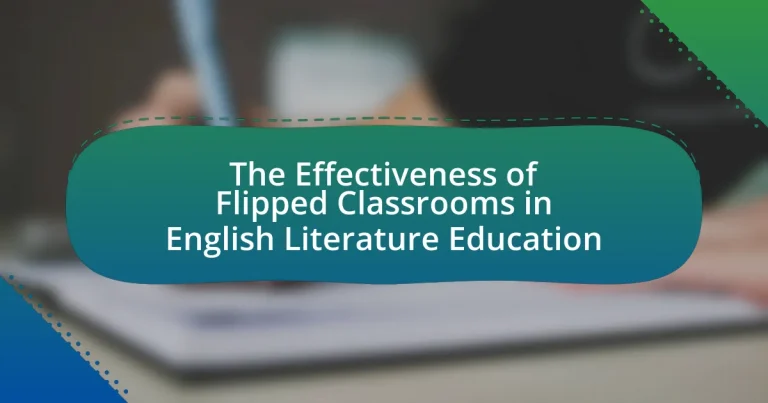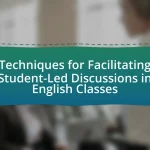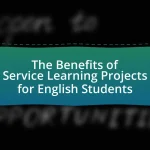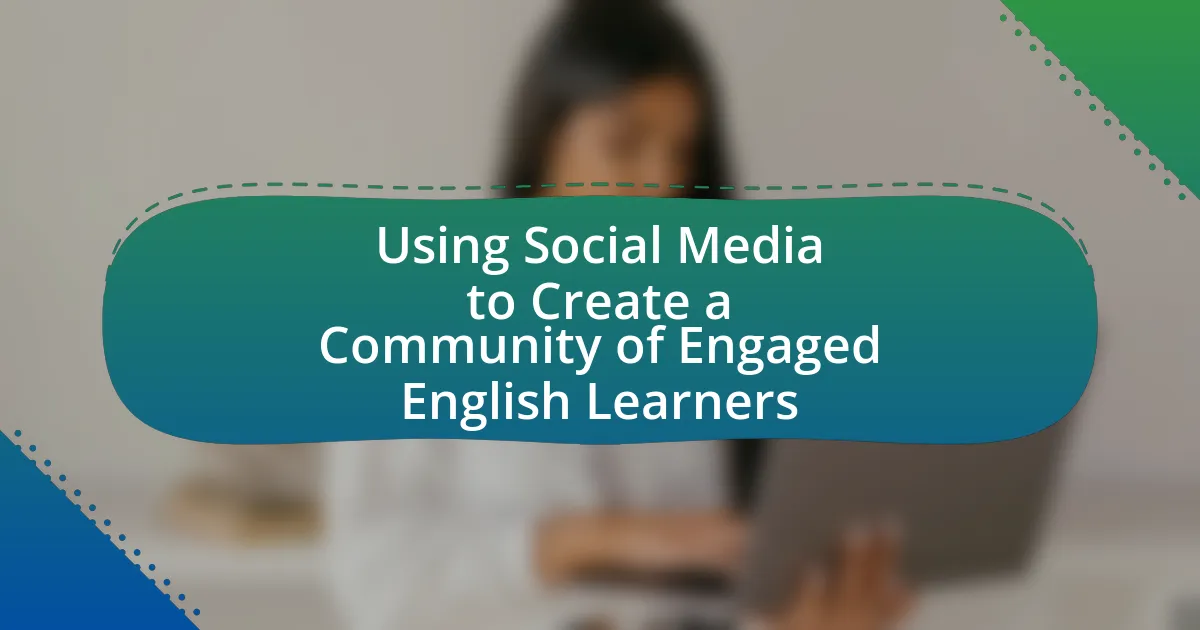The article examines the effectiveness of flipped classrooms in English literature education, highlighting their role in enhancing student engagement and comprehension. It discusses how flipped classrooms differ from traditional teaching methods by promoting active learning through pre-class preparation and interactive in-class activities. Key characteristics, theoretical foundations, and evidence supporting the benefits of this approach are presented, including improved academic performance and critical thinking skills. Additionally, the article addresses challenges educators face in implementing flipped classrooms and offers practical strategies for maximizing their effectiveness in literature curricula.
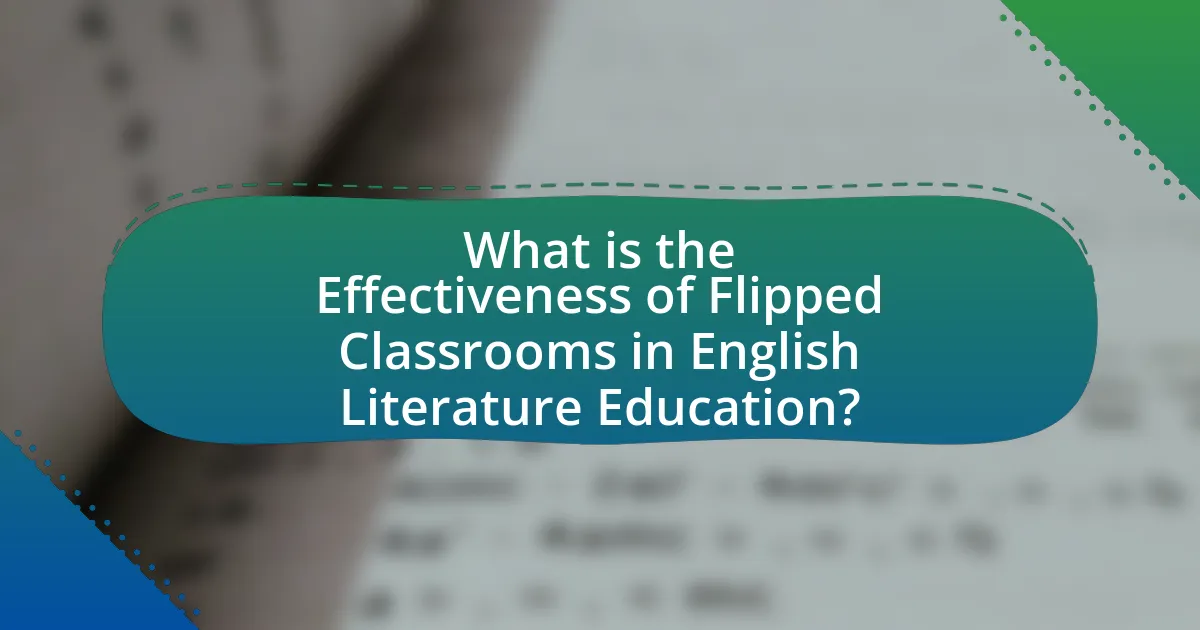
What is the Effectiveness of Flipped Classrooms in English Literature Education?
The effectiveness of flipped classrooms in English literature education is significant, as they enhance student engagement and comprehension. Research indicates that flipped classrooms promote active learning, allowing students to engage with literature more deeply through pre-class preparation and in-class discussions. A study by Bergmann and Sams (2012) found that students in flipped classrooms demonstrated improved academic performance and greater satisfaction compared to traditional teaching methods. Additionally, a meta-analysis published in the Journal of Educational Psychology in 2019 showed that flipped classrooms lead to higher retention rates and better critical thinking skills among students studying complex texts. These findings underscore the positive impact of flipped classrooms on the learning outcomes in English literature education.
How do flipped classrooms differ from traditional teaching methods?
Flipped classrooms differ from traditional teaching methods primarily in the structure of learning activities, where students engage with instructional content at home and participate in interactive, hands-on activities in class. In traditional teaching, the instructor delivers lectures during class time, while students complete assignments or review material at home. Research indicates that flipped classrooms can enhance student engagement and understanding, as evidenced by a study published in the “Journal of Educational Psychology,” which found that students in flipped classrooms demonstrated higher academic performance and satisfaction compared to those in traditional settings.
What are the key characteristics of flipped classrooms?
Flipped classrooms are characterized by the inversion of traditional teaching methods, where direct instruction occurs outside of the classroom, typically through video lectures, while in-class time is dedicated to interactive activities and discussions. This model promotes active learning, as students engage with the material at their own pace before class, allowing for deeper exploration and application of concepts during face-to-face interactions. Research indicates that this approach can enhance student engagement and improve learning outcomes, as evidenced by a study published in the “Journal of Educational Psychology,” which found that students in flipped classrooms performed better on assessments compared to those in traditional settings.
How does student engagement change in a flipped classroom setting?
Student engagement significantly increases in a flipped classroom setting. In this model, students prepare for class by reviewing instructional materials at home, which allows for more interactive and collaborative activities during class time. Research indicates that this approach fosters greater participation, as students are more likely to engage in discussions and group work when they have already encountered the material. A study by Bishop and Verleger (2013) found that flipped classrooms lead to higher levels of student engagement and satisfaction compared to traditional teaching methods, as students take more responsibility for their learning and feel more prepared to contribute in class.
What are the theoretical foundations supporting flipped classrooms?
The theoretical foundations supporting flipped classrooms include constructivism, active learning, and cognitive load theory. Constructivism posits that learners construct knowledge through experiences and interactions, which aligns with the flipped classroom model that encourages students to engage with content before class. Active learning emphasizes student participation and collaboration, which are integral to flipped classrooms as they facilitate discussions and problem-solving during class time. Cognitive load theory suggests that managing the amount of information presented to students can enhance learning; flipped classrooms allow for pre-class preparation, reducing cognitive overload during in-class activities. These theories collectively support the effectiveness of flipped classrooms in promoting deeper understanding and engagement in English literature education.
How does constructivist theory apply to flipped classrooms?
Constructivist theory applies to flipped classrooms by emphasizing active learning and student engagement, which are central to the flipped classroom model. In this approach, students first encounter new content outside of class, typically through videos or readings, allowing them to construct their understanding at their own pace. This aligns with constructivist principles that advocate for learners to build knowledge through experiences and interactions. Research indicates that when students engage in collaborative activities during class time, as encouraged by the flipped model, they deepen their understanding and retention of material, which is supported by studies showing improved academic performance in environments that foster active learning.
What role does active learning play in the effectiveness of flipped classrooms?
Active learning significantly enhances the effectiveness of flipped classrooms by promoting student engagement and deeper understanding of the material. In flipped classrooms, students first encounter new content outside of class, typically through videos or readings, and then use class time for interactive activities that reinforce learning. This approach allows students to actively participate in discussions, collaborate with peers, and apply concepts in real-time, which has been shown to improve retention and comprehension. Research indicates that active learning strategies can lead to higher academic performance; for instance, a meta-analysis by Freeman et al. (2014) found that students in active learning environments performed significantly better than those in traditional lectures, with an average increase of 6% in exam scores. Thus, active learning is crucial in maximizing the benefits of flipped classrooms in English literature education.
What evidence exists regarding the effectiveness of flipped classrooms in English literature education?
Evidence indicates that flipped classrooms enhance student engagement and comprehension in English literature education. Studies, such as one conducted by O’Flaherty and Phillips (2015), demonstrate that students in flipped classrooms show improved academic performance and greater satisfaction compared to traditional teaching methods. Additionally, research by Bergmann and Sams (2012) highlights that flipped classrooms facilitate deeper discussions and critical thinking, as students come prepared to engage with the material. These findings collectively support the effectiveness of flipped classrooms in fostering a more interactive and student-centered learning environment in English literature.
What studies have been conducted on flipped classrooms in literature courses?
Studies on flipped classrooms in literature courses have demonstrated positive impacts on student engagement and learning outcomes. For instance, a study by O’Flaherty and Phillips (2015) published in the Journal of Educational Technology & Society found that students in a flipped literature course reported higher levels of engagement and improved academic performance compared to traditional teaching methods. Additionally, a research project by Talbert (2017) highlighted that students in a flipped classroom setting showed enhanced critical thinking skills when analyzing literary texts. These findings collectively support the effectiveness of flipped classrooms in enhancing the educational experience in literature courses.
How do student outcomes compare between flipped classrooms and traditional classrooms?
Student outcomes in flipped classrooms generally show improved performance compared to traditional classrooms. Research indicates that students in flipped classrooms often achieve higher test scores and demonstrate better engagement and understanding of the material. For instance, a study by O’Flaherty and Phillips (2015) found that students in flipped classrooms scored an average of 10% higher on assessments than their peers in traditional settings. Additionally, the interactive nature of flipped classrooms fosters greater collaboration and critical thinking skills, which are essential in English literature education.
What challenges do educators face when implementing flipped classrooms?
Educators face several challenges when implementing flipped classrooms, including student resistance to new learning methods, the need for reliable technology, and the requirement for effective instructional design. Student resistance can stem from a lack of familiarity with self-directed learning, which may hinder engagement and participation. Additionally, educators must ensure that all students have access to the necessary technology, as disparities in resources can create inequities in learning opportunities. Effective instructional design is crucial, as educators need to create engaging and meaningful content for students to interact with outside of class, which can be time-consuming and requires expertise in digital tools. These challenges can impact the overall effectiveness of flipped classrooms in enhancing student learning outcomes in English literature education.
What technological barriers might hinder the effectiveness of flipped classrooms?
Technological barriers that might hinder the effectiveness of flipped classrooms include inadequate access to reliable internet, lack of appropriate devices for all students, and insufficient technical support for both educators and learners. In many regions, students may not have consistent internet access, which limits their ability to engage with online materials. A report by the Pew Research Center indicates that approximately 15% of U.S. households with school-age children do not have high-speed internet access, which directly impacts their ability to participate in flipped classroom models. Additionally, if students lack personal devices, such as laptops or tablets, they may struggle to complete assignments or access instructional videos. Furthermore, educators may face challenges in integrating technology effectively due to a lack of training or support, which can lead to ineffective implementation of the flipped classroom approach.
How can educators address resistance from students or faculty?
Educators can address resistance from students or faculty by fostering open communication and actively involving them in the learning process. Engaging students and faculty in discussions about the benefits and structure of flipped classrooms can alleviate concerns and resistance. Research indicates that when educators provide clear explanations of how flipped classrooms enhance learning outcomes, such as improved student engagement and performance, resistance diminishes. For instance, a study published in the “Journal of Educational Psychology” found that students who understood the rationale behind flipped classrooms reported higher satisfaction and lower resistance levels.
How can flipped classrooms be effectively integrated into English literature curricula?
Flipped classrooms can be effectively integrated into English literature curricula by assigning students pre-class readings and multimedia content that introduce key themes and concepts, allowing for deeper in-class discussions and analyses. This approach encourages active learning, as students come prepared to engage with the material, fostering critical thinking and collaborative skills. Research indicates that this method enhances student engagement and comprehension, as evidenced by a study conducted by Bergmann and Sams, which found that students in flipped classrooms demonstrated improved academic performance and greater satisfaction with their learning experience.
What strategies can teachers use to design effective flipped lessons?
Teachers can design effective flipped lessons by incorporating pre-class video lectures, interactive online quizzes, and structured in-class activities that promote active learning. Pre-class video lectures allow students to engage with content at their own pace, which has been shown to enhance understanding and retention. Interactive online quizzes can assess student comprehension and provide immediate feedback, facilitating targeted in-class discussions. Structured in-class activities, such as group projects or Socratic seminars, encourage collaboration and deeper exploration of the material, aligning with research that indicates active learning strategies significantly improve student outcomes in literature education.
How can assessment methods be adapted for flipped classroom environments?
Assessment methods can be adapted for flipped classroom environments by incorporating formative assessments that focus on student engagement and understanding during in-class activities. In flipped classrooms, traditional assessments, such as midterms and finals, can be supplemented with ongoing evaluations like peer assessments, self-assessments, and collaborative projects that reflect real-time learning. Research indicates that formative assessments enhance student learning by providing immediate feedback, which is crucial in a flipped model where students engage with content outside of class and apply it during class time. For example, a study by Bergmann and Sams (2012) highlights that formative assessments in flipped classrooms lead to improved student performance and deeper comprehension of material.
What best practices can enhance the effectiveness of flipped classrooms in English literature education?
Best practices that can enhance the effectiveness of flipped classrooms in English literature education include the use of engaging multimedia resources, structured pre-class assignments, and active in-class activities. Engaging multimedia resources, such as video lectures and interactive presentations, can capture students’ interest and provide diverse perspectives on literary texts. Structured pre-class assignments, like reading specific chapters or analyzing themes, ensure that students come prepared for discussions, fostering deeper understanding. Active in-class activities, such as group discussions, debates, and creative projects, promote collaboration and critical thinking, allowing students to apply their knowledge in meaningful ways. Research indicates that these practices lead to improved student engagement and academic performance in literature courses, as evidenced by studies showing higher retention rates and enhanced analytical skills among students in flipped classroom settings.
What resources are available for teachers to improve flipped classroom implementation?
Teachers can access various resources to enhance flipped classroom implementation, including online platforms, professional development workshops, and instructional materials. Online platforms such as Edpuzzle and Flipgrid allow educators to create interactive video lessons and facilitate student engagement. Professional development workshops, often provided by educational institutions or organizations like the International Society for Technology in Education (ISTE), offer training on best practices for flipped classrooms. Additionally, instructional materials, including lesson plans and case studies from sources like the Flipped Learning Network, provide concrete examples and strategies for effective implementation. These resources collectively support teachers in refining their flipped classroom approaches, leading to improved student outcomes in English literature education.
How can collaboration among educators improve flipped classroom outcomes?
Collaboration among educators can significantly improve flipped classroom outcomes by fostering shared strategies and resources that enhance student engagement and learning. When educators work together, they can develop cohesive lesson plans that align with the flipped classroom model, ensuring that instructional materials are effectively utilized. Research indicates that collaborative teaching practices lead to increased student achievement; for instance, a study by Vescio, Ross, and Adams (2008) found that professional learning communities positively impact student outcomes by promoting collective responsibility among teachers. This collaboration allows educators to share best practices, provide mutual support, and create a more dynamic learning environment, ultimately leading to improved academic performance in flipped classrooms.
What are the future implications of flipped classrooms in English literature education?
Flipped classrooms in English literature education are likely to enhance student engagement and improve comprehension of complex texts. This pedagogical approach allows students to access instructional content at home, freeing up classroom time for interactive discussions and collaborative analysis of literature. Research indicates that this model can lead to higher academic performance; for instance, a study by Bergmann and Sams found that students in flipped classrooms demonstrated increased understanding and retention of material compared to traditional settings. Additionally, the future implications include the potential for personalized learning experiences, as students can progress at their own pace, fostering a deeper appreciation for literature and critical thinking skills.
How might technology evolve to support flipped classrooms further?
Technology might evolve to support flipped classrooms further by integrating advanced artificial intelligence and adaptive learning systems. These systems can analyze student performance in real-time, providing personalized content and resources tailored to individual learning needs. For instance, platforms like Knewton and DreamBox Learning utilize data analytics to adjust the difficulty of assignments based on student interactions, enhancing engagement and comprehension. Additionally, augmented reality (AR) and virtual reality (VR) can create immersive learning experiences, allowing students to explore literary settings and contexts interactively, which has been shown to improve retention and understanding of complex themes in literature.
What trends are emerging in literature education that could influence flipped classroom effectiveness?
Emerging trends in literature education that could influence flipped classroom effectiveness include the integration of digital storytelling, collaborative learning, and personalized learning pathways. Digital storytelling enhances student engagement by allowing learners to create narratives using multimedia tools, which aligns with the flipped classroom model that emphasizes active learning. Collaborative learning fosters peer interaction and critical thinking, essential components of literature analysis, and is facilitated by the flipped classroom’s focus on in-class discussions. Personalized learning pathways cater to individual student needs and interests, enabling differentiated instruction that can be effectively implemented in a flipped classroom setting. These trends are supported by research indicating that active engagement and tailored learning experiences significantly improve student outcomes in literature education.
What practical tips can educators follow to maximize the effectiveness of flipped classrooms?
Educators can maximize the effectiveness of flipped classrooms by ensuring that pre-class materials are engaging and accessible. Providing high-quality video lectures, interactive quizzes, and reading assignments tailored to students’ interests can enhance motivation and comprehension. Research indicates that students are more likely to engage with content when it is relevant and presented in varied formats, which supports diverse learning styles. Additionally, incorporating regular feedback mechanisms, such as surveys or discussion forums, allows educators to gauge student understanding and adjust instructional strategies accordingly. This approach fosters a more responsive learning environment, ultimately leading to improved academic outcomes in English literature education.
